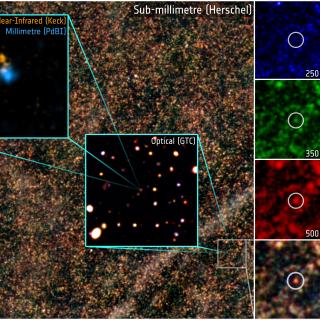Bibcode
Viero, M. P.; Moncelsi, L.; Quadri, R. F.; Béthermin, M.; Bock, J.; Burgarella, D.; Chapman, S. C.; Clements, D. L.; Conley, A.; Conversi, L.; Duivenvoorden, S.; Dunlop, J. S.; Farrah, D.; Franceschini, A.; Halpern, M.; Ivison, R. J.; Lagache, G.; Magdis, G.; Marchetti, L.; Álvarez-Márquez, J.; Marsden, G.; Oliver, S. J.; Page, M. J.; Pérez-Fournon, I.; Schulz, B.; Scott, Douglas; Valtchanov, I.; Vieira, J. D.; Wang, L.; Wardlow, J.; Zemcov, M.
Bibliographical reference
The Astrophysical Journal Letters, Volume 809, Issue 2, article id. L22, 6 pp. (2015).
Advertised on:
8
2015
Citations
17
Refereed citations
15
Description
We report contributions to cosmic infrared background (CIB) intensities
originating from known galaxies and their faint companions at
submillimeter wavelengths. Using the publicly available UltraVISTA
catalog and maps at 250, 350, and 500 μm from the Herschel
Multi-tiered Extragalactic Survey, we perform a novel measurement that
exploits the fact that uncataloged sources may bias stacked flux
densities—particularly if the resolution of the image is
poor—and intentionally smooth the images before stacking and
summing intensities. By smoothing the maps we are capturing the
contribution of faint (undetected in {K}S∼ 23.4) sources
that are physically associated, or correlated, with the detected
sources. We find that the cumulative CIB increases with increased
smoothing, reaching 9.82 ± 0.78, 5.77 ± 0.43 and 2.32+/-
0.19 {{nWm}}-2 {{sr}}-1 at 250, 350, and 500 μm
at 300 {arcsec} FWHM. This corresponds to a fraction of the fiducial CIB
of 0.94 ± 0.23, 1.07 ± 0.31, and 0.97 ± 0.26 at
250, 350, and 500 μm, where the uncertainties are dominated by those
of the absolute CIB. We then propose, with a simple model combining
parametric descriptions for stacked flux densities and stellar mass
functions, that emission from galaxies with log(M/{M}ȯ
)\gt 8.5 can account for most of the measured total intensities
and argue against contributions from extended, diffuse emission.
Finally, we discuss prospects for future survey instruments to improve
the estimates of the absolute CIB levels, and observe any potentially
remaining emission at z\gt 4.
Related projects

Formation and Evolution of Galaxies: Observations in Infrared and other Wavelengths
This IAC research group carries out several extragalactic projects in different spectral ranges, using space as well as ground-based telescopes, to study the cosmological evolution of galaxies and the origin of nuclear activity in active galaxies. The group is a member of the international consortium which built the SPIRE instrument for the
Ismael
Pérez Fournon